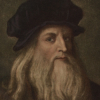Leonardo da Vinci

Leonardo da Vinci
Leonardo di ser Piero da Vinci, more commonly Leonardo da Vinci or simply Leonardoˈvintʃi] ; 15 April 1452 – 2 May 1519), was an Italian polymath whose areas of interest included invention, painting, sculpting, architecture, science, music, mathematics, engineering, literature, anatomy, geology, astronomy, botany, writing, history, and cartography. He has been variously called the father of paleontology, ichnology, and architecture, and is widely considered one of the greatest painters of all time. Sometimes credited with the inventions of the parachute, helicopter and tank,...
NationalityItalian
ProfessionPainter
Date of Birth15 April 1452
CityVinci, Italy
CountryItaly
When once you have tasted flight, you will forever walk the earth with your eyes turned skyward, for there you have been, and there you will always long to return.
The eye sees a thing more clearly in dreams than the imagination awake.
The human being, creature of eyes, needs the image.
Although the poet has as wide a choice of subjects as the painter, his creations fail to afford as much satisfaction to mankind as do paintings... if the poet serves the understanding by way of the ear, the painter does so by the eye, which is the nobler sense.
The soul is content to stay imprisoned in the human body... for through the eyes all the various things of nature are represented to the soul.
The instant the atmosphere is illuminated it will be filled with an infinite number of images which are produced by the various bodies and colours assembled in it. And the eye is the target, a lodestone, of these images.
Of several bodies all equally larger and distant, that most brightly illuminated will appear to the eye nearest and largest.
The painter who draws by practise and judgment of the eye without the use of reason is like the mirror which reproduces within itself all the objects which are set opposite to it without knowledge of the same.
The mole has very small eyes and it always lives under ground; and it lives as long as it is in the dark but when it comes into the light it dies immediately, because it becomes known;--and so it is with lies.
The eye - which sees all objects reversed - retains the images for some time.
The eye which turns from a white object in the light of the sun and goes into a less fully lighted place will see everything as dark.
Perspective is nothing more than a rational demonstration applied to the consideration of how objects in front of the eye transmit their image to it, by means of a pyramid of lines. The Pyramid is the name I apply to the lines which, starting from the surface and edges of each object, converge from a distance and meet in a single point.
The eye, the window of the soul, is the chief means whereby the understanding can most fully and abundantly appreciate the infinite works of Nature; and the ear is second.
I roamed the countryside searching for the answers to things I did not understand. Why shells existed on the tops of mountains along with the imprints of coral and plant and seaweed usually found in the sea. Why the thunder lasts a longer time than that which causes it and why immediately on its creation the lightening becomes visible to the eye while thunder requires time to travel. How the various circles of water form around the spot which has been struck by a stone and why a bird sustains itself in the air. These questions and other strange phenomena engaged my thought throughout my life.